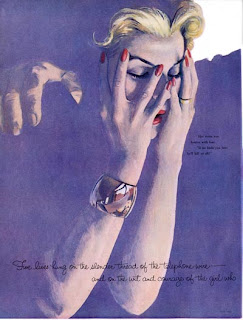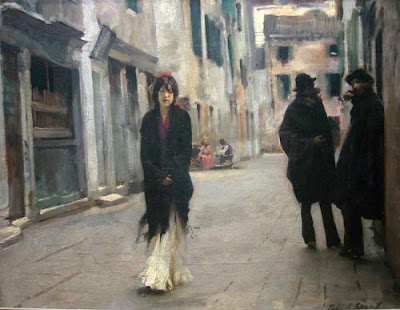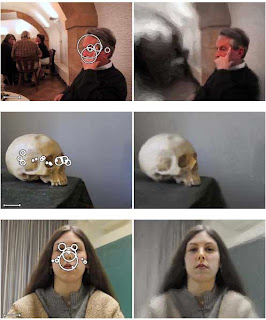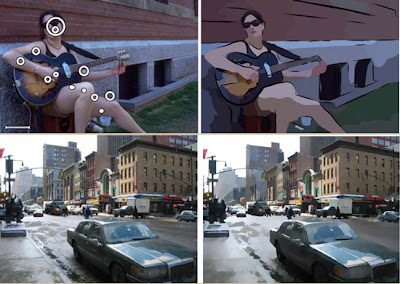One of the reasons we like to look at paintings is that reality is filtered through someone's brain. Painters select the important elements out of the infinite detail that meets our eyes.

Here, Al Parker chooses to show us detail in the hands and face. He sinks everything else into a flat tone.

John Singer Sargent could have detailed every paving stone and roof tile in this Venice street scene. Instead he softened and simplified the background areas and put the focus on the faces.
This selectivity isn’t arbitrary. The detailed areas correspond with the parts of the picture that we want to look at anyway. As we’ve seen in previous posts, eye tracking studies have demonstrated the cognitive basis of selective attention. Viewers’ eyes consistently go to areas of a picture with the greatest psychological salience: things like faces, hands, and signs. We’re hard-wired for it.
What happens if you combine eye tracking data with computer graphics algorithms to automate the process of selective omission? Would the result look “expressive” or “artistic?”

(Click to enlarge) In his doctoral thesis for Rutgers University, Anthony Santella did just that. The photographs on the left include a set of overlapping circles showing where most people spent their time looking in each image. The larger the circle, the longer the concentration on those areas.
Santella combined that data with a rendering algorithm which simplified other areas of the image. In the top image, note the flattening of the far figures and the arches above them. In the bottom image of the woman, note how the wrinkles in the drapes and the textures in the sweater are rendered with flat tones. But her eyes, nose and mouth are still detailed.

The rendering algorithms can be designed to interpret the source photo in terms of line and color. Or the shapes can modulated in size according to the interest factor. Note how the outlying areas of each rendering is simplified.
Whichever rendering style one desires, the output image has a sense of psychological relevance, more so than
rendering algorithms based merely on abstract principles such as edge detection. As a result these computer-modified photographs have a sense of something approaching true human artistry.
The results of this interaction between eye-tracking data and computer rendering algorithms suggests a heretical thought: What we think of as a rare gift of expressive artistic judgment is really something fairly simple and logical, something you can teach a machine to do.
"THE ART OF SEEING: VISUAL PERCEPTION IN
DESIGN AND EVALUATION OF
NON-PHOTOREALISTIC RENDERING"
by Anthony Santella
www.research.rutgers.edu/~asantell/thesis.pdf
Final two sets of images are courtesy this online graduate thesis.
Previous related posts on GurneyJourney:
Abstraction Generator
Automated Painting
Al Parker at the Rockwell
The Eyes Have It
Stroke Module
Eyetracking and Composition, part 1
Eyetracking and Composition, part 2
Eyetracking and Composition part 3
Introduction to eyetracking,
link.
How perception of faces is coded differently,
link.












































